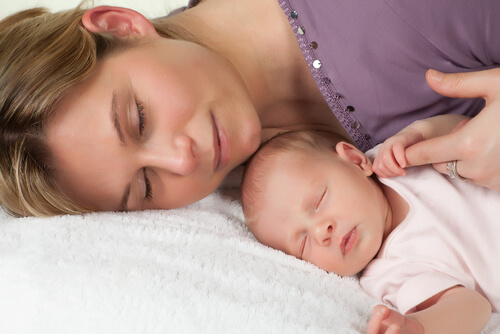Measures To Reduce The Risk Of Sudden Infant Death Syndrome

There are certain strategies that can help prevent sudden infant death syndrome. Measures include breastfeeding, the use of pacifiers, keeping your baby’s room at a cool temperature, vaccinating your baby, putting them to bed face up, and sharing a room with them.
One of the most difficult events that can happen to any mother or father is losing their child to sudden infant death syndrome (SIDS).
This diagnosis is used when a child under one year of age dies suddenly and when no exact cause of death can be determined, even after a thorough medical and legal investigation, including an autopsy.
The statistics presented in the White Paper on Sudden Death, published by the Spanish Pediatric Association, say that in Spain each year about 900 infants die due to SIDS.
This syndrome is also the leading cause of death for babies between 1 month and 1 year of age in the USA. Approximately 2,300 babies die from SIDS in the US every year.
Sudden death most often affects babies who are between 1 and 4 months old, and in 90% of cases, babies less than 6 months old.

Why it happens
Most experts believe that SIDS can occur when a baby has an underlying vulnerability (for example, an abnormal or immature functioning of the heart or respiratory system); or is exposed to certain risk factors (such as sleeping on their stomach or with soft or padded bedding) during a crucial period of their development.
But the truth is that they still have no scientific basis to explain why children die suddenly. What is certain is that it is not isolated or infrequent. Therefore, a group of pediatricians has devised certain strategies to prevent this syndrome from affecting children.
One of them is to place the baby to sleep in the supine position. That means that the child must be face up.
This contradicts what our mothers and grandmothers have always told us when they recommended we let children sleep on their stomach or on their side to prevent them from drowning due to vomit. And although some pediatricians continue to advise that, science says otherwise.
In 2000, the American Academy of Pediatrics (AAP) revised its previous recommendations to reduce the risk of crib death: recent research has shown that the safest position to put a baby to sleep is on their back.
When a baby sleeps on their stomach, they are more likely to overheat, to have pauses in breathing, and to breathe in the air they have just exhaled, which lacks oxygen.
“A group of researchers found that babies who had died of sudden death had lower than normal serotonin levels in the brainstem. Serotonin regulates breathing, heart rate, and blood pressure while we sleep. Experts continue to study the brain, the autonomic nervous system, and genetics, in search of answers. “
-American Medical Association Journal-
The councils of the AAP recommend:
- Sleeping in the supine position (on the back).
- Use of a hard surface (mattress).
- Breastfeeding.
- Sharing the room with the infant, but not the bed.
- Vaccinating the baby.
Other recommendations
When considering the use of pacifiers, it is recommended as a protective factor against SIDS.
They also suggest avoiding soft protectors/pillows/blankets in the crib which could suffocate the infant. Also avoid excessive heat in the room.
Avoid exposure to tobacco, in all its forms. Discourage pregnant women from smoking, and from others smoking around them.
Similarly, they discourage the use of alcohol and/or any other type of drug by both parents.

Share the room
One of the recommendations from the pediatricians is to share the room with the baby so that the little one has more attention. They do not advise sharing the bed, although that is up for discussion.
There are cultures and experts who are in favor of co-sleeping, which consists of the child sleeping with an adult, usually in bed and with the mother frequently, and for several hours at a time.
Co-sleeping, a widespread and ancestral practice, has ceased to be practiced in Western countries within the last 200 years. Without evidence, it is argued that an early separation from the mother would favor a greater autonomy of the child.
This custom is deeply rooted in Japan, Hong Kong, and immigrants from Bangladesh in London, cultures in which incidences of SIDS are very low.
Some studies say that bed sharing improves respiratory stability, oxygenation and thermoregulation, and causes synchronized awakenings with the mother.
It also increases independence and improves children’s psychological development and does not cause any alleged behavioral or personality problems.
All cited sources were thoroughly reviewed by our team to ensure their quality, reliability, currency, and validity. The bibliography of this article was considered reliable and of academic or scientific accuracy.
- SUBITA, G. D. T. E. M. (2000). Nuevas recomendaciones para la disminución del riesgo del síndrome de muerte súbita del lactante. Arch. argent. pediatr, 98(4), 239. https://www.sap.org.ar/docs/publicaciones/archivosarg/2000/00_239_243.pdf
- Jenik, D. A., & Rivarola, M. R. (1995). Muerte súbita del lactante:¿ es posible disminuir el riesgo?. Arch. argent. pediatr, 58-9. https://www.sids.org.ar/m_smsl6.htm
- Martínez Alcazar, M. A. (2019). Muerte súbita del lactante. Qué hacemos y qué debemos hacer para prevenirla. http://189.203.43.34:8180/handle/20.500.12103/1793
This text is provided for informational purposes only and does not replace consultation with a professional. If in doubt, consult your specialist.
